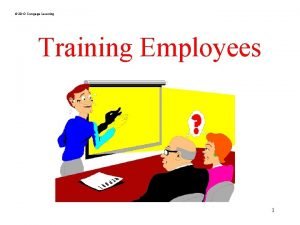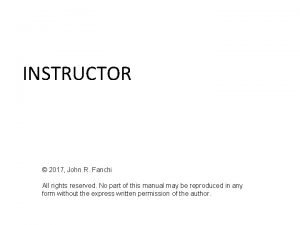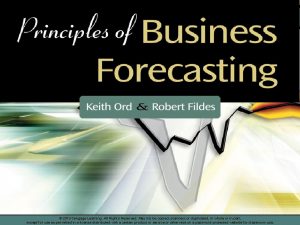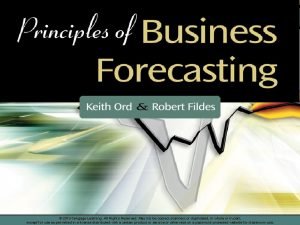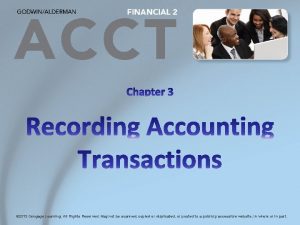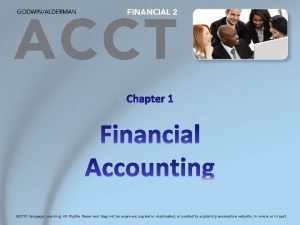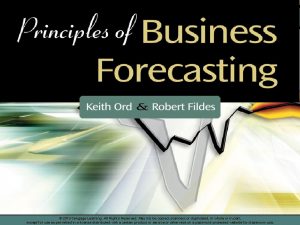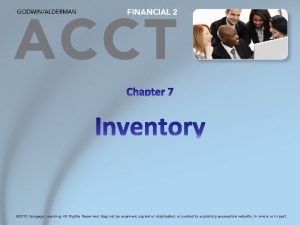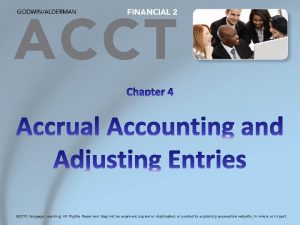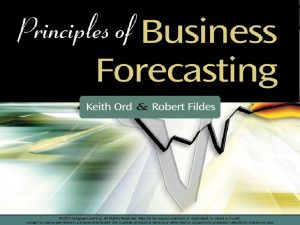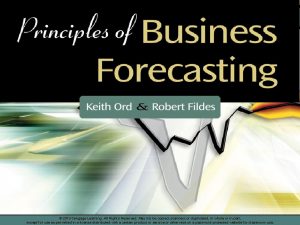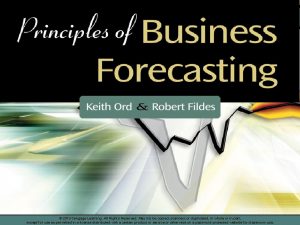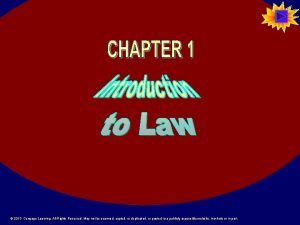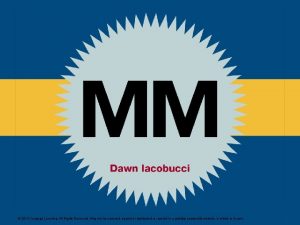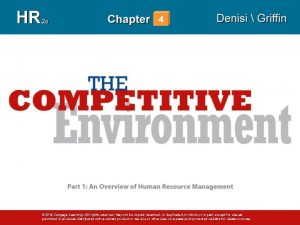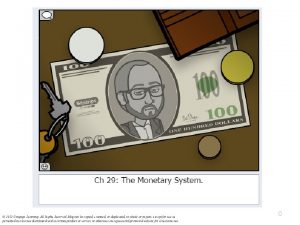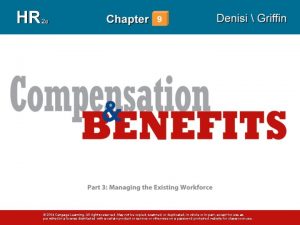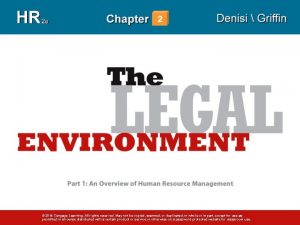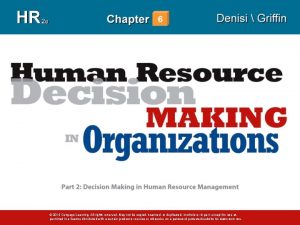2013 Cengage Learning All Rights Reserved May not








































- Slides: 40

© 2013 Cengage Learning. All Rights Reserved. May not be copied, scanned, or duplicated, in whole or in part, except for use as permitted in a license distributed with a certain product or service or otherwise on a password-protected website for classroom use.

Chapter 8: Multiple Regression for Time Series 8. 1 Graphical analysis and preliminary model development 8. 2 The multiple regression model 8. 3 Testing the overall model 8. 4 Testing individual coefficients 8. 5 Checking the assumptions 8. 6 Forecasting with multiple regression 8. 7 Principles 2 © 2013 Cengage Learning. All Rights Reserved. May not be copied, scanned, or duplicated, in whole or in part, except for use as permitted in a license distributed with a certain product or service or otherwise on a password-protected website for classroom use.

8. 1: Graphical Analysis and Preliminary Model Development • Suppose we are interested in the level of gas prices as a function of various explanatory variables. • Observe Gas Prices (=Yt) over n time periods, t = 1, 2, …, n Step 1: DDD, a time plot of Y against time Step 2: produce a scatter plot of Y against each explanatory variable Xj o For step 2, identify possible variables: § Personal Disposable Income § Unemployment § S&P 500 Index § Price of crude oil Q: What other variables would be of potential interest? 3 © 2013 Cengage Learning. All Rights Reserved. May not be copied, scanned, or duplicated, in whole or in part, except for use as permitted in a license distributed with a certain product or service or otherwise on a password-protected website for classroom use.

8. 1: Graphical Analysis and Preliminary Model Development Time Series Plot of Unleaded ©Cengage Learning 2013. © 2013 Cengage Learning. All Rights Reserved. May not be copied, scanned, or duplicated, in whole or in part, except for use as permitted in a license distributed with a certain product or service or otherwise on a password-protected website for classroom use. 4

Figure 8. 1: Matrix Plot for Unleaded Data shown is from file Gas_prices_1. xlsx; adapted from Minitab output. 5 © 2013 Cengage Learning. All Rights Reserved. May not be copied, scanned, or duplicated, in whole or in part, except for use as permitted in a license distributed with a certain product or service or otherwise on a password-protected website for classroom use.

Example 8. 2: Correlation Analysis for Unleaded First row: Pearson correlation Second row: P-Value 6 © 2013 Cengage Learning. All Rights Reserved. May not be copied, scanned, or duplicated, in whole or in part, except for use as permitted in a license distributed with a certain product or service or otherwise on a password-protected website for classroom use.

8. 2: The Multiple Regression Model • Assume a linear relation between Y and X 1, …, XK where: β 0 = intercept (value of Y when all Xj = 0) βj = expected effect of Xj on Y, all other factors fixed ε = random error • Expected value of Y given the {Xj}: • So 7 © 2013 Cengage Learning. All Rights Reserved. May not be copied, scanned, or duplicated, in whole or in part, except for use as permitted in a license distributed with a certain product or service or otherwise on a password-protected website for classroom use.

8. 2. 1: The Method of Ordinary Least Squares (OLS) • Define error = Observed – Fitted • Estimate the intercept and slope coefficients by minimizing the sum of squared errors (SSE). That is, choose the coefficients to minimize: 8 © 2013 Cengage Learning. All Rights Reserved. May not be copied, scanned, or duplicated, in whole or in part, except for use as permitted in a license distributed with a certain product or service or otherwise on a password-protected website for classroom use.

8. 3: Testing the Overall Model Is the overall model of value? ©Cengage Learning 2013. 9 © 2013 Cengage Learning. All Rights Reserved. May not be copied, scanned, or duplicated, in whole or in part, except for use as permitted in a license distributed with a certain product or service or otherwise on a password-protected website for classroom use.

8. 3: Testing the Overall Model 10 © 2013 Cengage Learning. All Rights Reserved. May not be copied, scanned, or duplicated, in whole or in part, except for use as permitted in a license distributed with a certain product or service or otherwise on a password-protected website for classroom use.

8. 3: Testing the Overall Model • The decision rule for all the tests o is reject H 0 if p < where p is the observed significance level, and o is the significance level used for testing, typically 0. 05. o The rule implies that we do not reject H 0 if p > . • Degrees of Freedom (DF): o n = sample size o K = # explanatory variables o DF = n-K-1 Q: Why do we “lose” degrees of freedom? 11 © 2013 Cengage Learning. All Rights Reserved. May not be copied, scanned, or duplicated, in whole or in part, except for use as permitted in a license distributed with a certain product or service or otherwise on a password-protected website for classroom use.

8. 3: Testing the Overall Model • Overall F test--is the overall model of value? • H 0: all slopes are zero vs. HA: at least one slope non-zero • Reject H 0 if Fobserved > Ftables OR if P < α Q: What is the conclusion? 12 © 2013 Cengage Learning. All Rights Reserved. May not be copied, scanned, or duplicated, in whole or in part, except for use as permitted in a license distributed with a certain product or service or otherwise on a password-protected website for classroom use.

8. 3. 2: ANOVA in Simple Regression Summary Measures • Mean Square Error: • Root Mean Square Error (RMSE): • Coefficient of Determination (R 2): Q: Interpret S and R 2 13 © 2013 Cengage Learning. All Rights Reserved. May not be copied, scanned, or duplicated, in whole or in part, except for use as permitted in a license distributed with a certain product or service or otherwise on a password-protected website for classroom use.

8. 3. 2: ANOVA in Simple Regression Summary Measures • Adjusted Coefficient of Determination: • Relationship between F and R 2 : Q: Would a test using R 2 lead to different conclusions than the F test? Why or why not? 14 © 2013 Cengage Learning. All Rights Reserved. May not be copied, scanned, or duplicated, in whole or in part, except for use as permitted in a license distributed with a certain product or service or otherwise on a password-protected website for classroom use.

8. 4: Testing Individual Coefficients • t-tests: Are individual variables worth retaining in the model, given that the other variables are already in the model? o H 0: slope for Xi is zero, given other X’s in model; o HA: slope for Xi is not zero, given other X’s in model. • In multiple regression (i. e. K > 1), F provides an overall test; o the t-test gives information on individual coefficients, so that the two tests provide different information. 15 © 2013 Cengage Learning. All Rights Reserved. May not be copied, scanned, or duplicated, in whole or in part, except for use as permitted in a license distributed with a certain product or service or otherwise on a password-protected website for classroom use.

8. 4: Testing Individual Coefficients ©Cengage Learning 2013. 16 © 2013 Cengage Learning. All Rights Reserved. May not be copied, scanned, or duplicated, in whole or in part, except for use as permitted in a license distributed with a certain product or service or otherwise on a password-protected website for classroom use.

Figure 8. 3: Single-Variable Tests for the Unleaded • The regression equation is Unleaded = 1. 0137 + 0. 022001 L 1_ crude – 0. 16398 L 1_Unemp 0. 0004063 L 1_SP 500 + 0. 00012541 L 1_PDI Predictor Coef SE Coef T P Constant 1. 0137 0. 2163 4. 69 0. 000 L 1_ crude 0. 022001 0. 001068 20. 60 0. 000 L 1_ Unemp -0. 16397 0. 03752 -4. 37 0. 000 L 1_SP 500 -0. 0004063 0. 000136 -2. 99 0. 003 L 1_PDI 0. 00012541 0. 00002324 5. 40 0. 000 Data shown is from file Gas_prices_1. xlsx. Q: Interpret the results 17 © 2013 Cengage Learning. All Rights Reserved. May not be copied, scanned, or duplicated, in whole or in part, except for use as permitted in a license distributed with a certain product or service or otherwise on a password-protected website for classroom use.

8. 4. 1: Case Study: Baseball Salaries • Examine the results for three and five variable models • What conclusions may be drawn? • How could the model be improved? 18 © 2013 Cengage Learning. All Rights Reserved. May not be copied, scanned, or duplicated, in whole or in part, except for use as permitted in a license distributed with a certain product or service or otherwise on a password-protected website for classroom use.

8. 4. 1: Correlation Analysis for Baseball Salaries (A) Salary Years in Career Innings Career ($000 s) Majors ERA Pitched Wins Salary ($000 s) Years in Majors 1. 00 0. 53 1. 00 Career ERA Innings Pitched -0. 34 -0. 22 1. 00 0. 27 0. 11 0. 09 1. 00 Career Wins 0. 51 0. 89 -0. 21 0. 33 1. 00 Career Losses 0. 49 0. 91 -0. 14 0. 30 0. 97 Career Losses 1. 00 Data shown is from file Baseball. xlsx; adapted from Minitab output. 19 © 2013 Cengage Learning. All Rights Reserved. May not be copied, scanned, or duplicated, in whole or in part, except for use as permitted in a license distributed with a certain product or service or otherwise on a password-protected website for classroom use.

8. 4. 1: Five Variable Model (B) Data shown is from file Baseball. xlsx; adapted from Minitab output. © 2013 Cengage Learning. All Rights Reserved. May not be copied, scanned, or duplicated, in whole or in part, except for use as permitted in a license distributed with a certain product or service or otherwise on a password-protected website for classroom use. 20

8. 4. 1 Three Variable Model (C) Data shown is from file Baseball. xlsx; adapted from Minitab output. © 2013 Cengage Learning. All Rights Reserved. May not be copied, scanned, or duplicated, in whole or in part, except for use as permitted in a license distributed with a certain product or service or otherwise on a password-protected website for classroom use. 21

8. 4. 2: Testing a Group of Coefficients • Model M 1 (with error sum of squares SSE 1) • Model M 0 (with error sum of squares SSE 0) Test • H 0: q+1 = q+2 =. . . = K = 0, given that X 1, …, Xq are in the model, against the alternative hypothesis: • HA: At least one of the coefficients q+1, …, K is nonzero when X 1, …, Xq are in the model. 22 © 2013 Cengage Learning. All Rights Reserved. May not be copied, scanned, or duplicated, in whole or in part, except for use as permitted in a license distributed with a certain product or service or otherwise on a password-protected website for classroom use.

8. 4 : Testing a Group of Coefficients Example 8. 4: Testing a Group of Coefficients • For the baseball data, testing the three-variable model against the five-variable model: Q: What is the conclusion? Hint: The expected value of F under H 0 is close to 1. 0 23 © 2013 Cengage Learning. All Rights Reserved. May not be copied, scanned, or duplicated, in whole or in part, except for use as permitted in a license distributed with a certain product or service or otherwise on a password-protected website for classroom use.

8. 5: Checking the Assumptions, I • Assumption R 1: For given values of the explanatory variables, X, the expected value of Y is written as E(Y|X) and has the form: • Potential Violation: We may have omitted a key variable 24 © 2013 Cengage Learning. All Rights Reserved. May not be copied, scanned, or duplicated, in whole or in part, except for use as permitted in a license distributed with a certain product or service or otherwise on a password-protected website for classroom use.

8. 5: Checking the Assumptions, II • Assumption R 2: The difference between an observed Y and its expectation is known as a random error, denoted by ε. Thus, the full model may be written as: • Potential Violations: Relate to the particular assumptions about the error terms 25 © 2013 Cengage Learning. All Rights Reserved. May not be copied, scanned, or duplicated, in whole or in part, except for use as permitted in a license distributed with a certain product or service or otherwise on a password-protected website for classroom use.

8. 5: Checking the Assumptions, III • Assumption R 3: The expected value of each error term is zero. That is there is no bias in the measurement process. • Potential Violation: Observations may contain bias. This assumption is not directly testable 26 © 2013 Cengage Learning. All Rights Reserved. May not be copied, scanned, or duplicated, in whole or in part, except for use as permitted in a license distributed with a certain product or service or otherwise on a password-protected website for classroom use.

8. 5: Checking the Assumptions, IV • Assumption R 4: The errors for different observations are uncorrelated with one another. When examining observations over time, this assumption corresponds to a lack of autocorrelation among the errors. • Potential Violation: The errors may be (auto)correlated. 27 © 2013 Cengage Learning. All Rights Reserved. May not be copied, scanned, or duplicated, in whole or in part, except for use as permitted in a license distributed with a certain product or service or otherwise on a password-protected website for classroom use.

8. 5: Checking the Assumptions, V • Assumption R 5: The variance of the errors is constant. That is, the error terms come from distributions with equal variances. When the assumption is satisfied the error process is homoscedastic. • Potential Violation: The variances are unequal; the error process is heteroscedastic. 28 © 2013 Cengage Learning. All Rights Reserved. May not be copied, scanned, or duplicated, in whole or in part, except for use as permitted in a license distributed with a certain product or service or otherwise on a password-protected website for classroom use.

8. 5: Checking the Assumptions, VI • Assumption R 6: The errors are drawn from a normal distribution. • Potential Violation: The error distribution is nonnormal • Assumptions R 3 – R 6 are typically combined into the statement that the errors are independent and normally distributed with zero means and equal variances • We now develop diagnostics to check whether these assumptions are reasonable. That is, do they appear to be consistent with the data? 29 © 2013 Cengage Learning. All Rights Reserved. May not be copied, scanned, or duplicated, in whole or in part, except for use as permitted in a license distributed with a certain product or service or otherwise on a password-protected website for classroom use.

8. 5: Checking the Assumptions, VII 30 © 2013 Cengage Learning. All Rights Reserved. May not be copied, scanned, or duplicated, in whole or in part, except for use as permitted in a license distributed with a certain product or service or otherwise on a password-protected website for classroom use.

Figure 8. 6 (A): Residuals Plots Data: Gas_prices_1. xlsx; adapted from Minitab output. © 2013 Cengage Learning. All Rights Reserved. May not be copied, scanned, or duplicated, in whole or in part, except for use as permitted in a license distributed with a certain product or service or otherwise on a password-protected website for classroom use. 31

8. 5. 1: Analysis of Residuals for Gas Price Data • Residuals appear to be approximately normal (Probability Plot and Histogram), but there are some outliers o Check the original data to identify the outliers and to determine possible explanations • Model does not capture time dependence o Zig-zag pattern in Residuals vs. Order • Errors are not homoscedastic o See in Residuals vs. Fitted Value • Increased volatility in the later part of the series o See in Residuals vs. Order • Some evidence of seasonal pattern o Look for peaks every 12 months in Residuals vs. Order 32 © 2013 Cengage Learning. All Rights Reserved. May not be copied, scanned, or duplicated, in whole or in part, except for use as permitted in a license distributed with a certain product or service or otherwise on a password-protected website for classroom use.

Appendix 8 A: The Durbin-Watson Statistic Checking for Autocorrelation • The classical approach is to use the Durbin-Watson Statistic–tests for first-order autocorrelation. The value of D will always be between 0 and 4, inclusive. • D=0 perfect positive autocorrelation (et = et– 1 for all points) • D=2 no autocorrelation • D=4 perfect negative autocorrelation (et = –et– 1 for all points) 33 © 2013 Cengage Learning. All Rights Reserved. May not be copied, scanned, or duplicated, in whole or in part, except for use as permitted in a license distributed with a certain product or service or otherwise on a password-protected website for classroom use.

Appendix 8 A: The Durbin-Watson Statistic Checking for Autocorrelation • Whether the statistic D indicates significant autocorrelation depends on the sample size, n, and the number and structure of the predictors in the regression model, K. • We use an approximate test that avoids the use of tables: o Reject H 0 if: • Further, if we reject H 0 and D<2, this implies positive autocorrelation [usual case in business applications]. • If we reject H 0 and D>2, this implies negative autocorrelation. 34 © 2013 Cengage Learning. All Rights Reserved. May not be copied, scanned, or duplicated, in whole or in part, except for use as permitted in a license distributed with a certain product or service or otherwise on a password-protected website for classroom use.

Appendix 8 A: The Durbin-Watson Statistic Durbin-Watson Test for Gas Prices • For model in Example 8. 1 we obtain DW = 0. 576 • Lower critical value is: • Clearly there is significant positive autocorrelation implying a carry-over effect from one month to the next. Q: What can we do about it? 35 © 2013 Cengage Learning. All Rights Reserved. May not be copied, scanned, or duplicated, in whole or in part, except for use as permitted in a license distributed with a certain product or service or otherwise on a password-protected website for classroom use.

8. 5. 1: Analysis of Residuals for Gas Price Data Durbin-Watson Test or ACF? • The Durbin-Watson test (see Appendix 8 A) examines only first order autocorrelation whereas the Autocorrelation Function (ACF) allows us to check for dependence at a range of possible lags. • Define the autocorrelation at lag k as • The ACF is the plot of rk against k, k=1, 2, …. o The approximate DW test matches the graphical test on r 1 given by the ACF 36 © 2013 Cengage Learning. All Rights Reserved. May not be copied, scanned, or duplicated, in whole or in part, except for use as permitted in a license distributed with a certain product or service or otherwise on a password-protected website for classroom use.

Figure 8. 7: ACF and PACF for the Residuals of Four. Variable Unleaded Gas Prices Model [Minitab] Data: Gas_prices_1. xlsx; adapted from Minitab output. 37 © 2013 Cengage Learning. All Rights Reserved. May not be copied, scanned, or duplicated, in whole or in part, except for use as permitted in a license distributed with a certain product or service or otherwise on a password-protected website for classroom use.

8. 6: Forecasting with Multiple Regression Given values of the inputs • The point forecast is given by: • The Prediction Interval is given by: where t denotes the appropriate percentage point from t-tables Example 8. 6 K = 4 and n = 155, so DF = 150. The SE for the point forecast is found to be 0. 1695. Using t 0. 025(150) = 1. 976, we find that the 95 percent prediction interval is 38 © 2013 Cengage Learning. All Rights Reserved. May not be copied, scanned, or duplicated, in whole or in part, except for use as permitted in a license distributed with a certain product or service or otherwise on a password-protected website for classroom use.

8. 7: Principles • Aim for a relatively simple model specification • Tailor the forecasting model to the horizon • Identify important causal variables on the basis of the underlying theory and earlier empirical studies. Identify suitable proxy variables when the variables of interest are not available in a timely fashion. • If the aim of the analysis is to provide pure forecasts o know the explanatory variables in advance o or be able to forecast them sufficiently well to justify their inclusion in the model. • Use the method of ordinary lest squares to estimate the parameters. • Update the estimates frequently. 39 © 2013 Cengage Learning. All Rights Reserved. May not be copied, scanned, or duplicated, in whole or in part, except for use as permitted in a license distributed with a certain product or service or otherwise on a password-protected website for classroom use.

Chapter 8: Take-Aways • Start the modeling process by careful consideration of available theory and previous empirical studies • Carry out a full preliminary analysis of the data to look for associations and for unusual observations • Test both the overall model and the individual components • Examine the validity of the underlying assumptions • Make sure that the model is “sensible” with respect to the signs and magnitudes of the slope coefficients • Use a hold-out sample to evaluate forecasting performance. 40 © 2013 Cengage Learning. All Rights Reserved. May not be copied, scanned, or duplicated, in whole or in part, except for use as permitted in a license distributed with a certain product or service or otherwise on a password-protected website for classroom use.
 Training evaluation
Training evaluation Specification by example
Specification by example Copyright 2015 all rights reserved
Copyright 2015 all rights reserved All rights reserved sentence
All rights reserved sentence Freesound content licence
Freesound content licence Confidential all rights reserved
Confidential all rights reserved Sentinel controlled repetition
Sentinel controlled repetition Copyright 2015 all rights reserved
Copyright 2015 all rights reserved Pearson education inc all rights reserved
Pearson education inc all rights reserved Microsoft corporation. all rights reserved.
Microsoft corporation. all rights reserved. Microsoft corporation. all rights reserved.
Microsoft corporation. all rights reserved. Microsoft corporation. all rights reserved
Microsoft corporation. all rights reserved Pearson education inc. all rights reserved
Pearson education inc. all rights reserved Dell all rights reserved copyright 2009
Dell all rights reserved copyright 2009 Warning all rights reserved
Warning all rights reserved Siprop
Siprop Quadratic equation cengage
Quadratic equation cengage Warning all rights reserved
Warning all rights reserved Confidential all rights reserved
Confidential all rights reserved Microsoft corporation. all rights reserved
Microsoft corporation. all rights reserved Pearson education inc. all rights reserved
Pearson education inc. all rights reserved Copyright © 2018 all rights reserved
Copyright © 2018 all rights reserved 2017 all rights reserved
2017 all rights reserved Copyright 2010 pearson education inc
Copyright 2010 pearson education inc Pearson education inc. all rights reserved
Pearson education inc. all rights reserved Confidential all rights reserved
Confidential all rights reserved Confidential all rights reserved
Confidential all rights reserved R rights reserved
R rights reserved Rights reserved
Rights reserved Hci patterns
Hci patterns 2009 delmar cengage learning
2009 delmar cengage learning Chapter 5 learning exercises medical terminology
Chapter 5 learning exercises medical terminology Cengage learning heart diagram
Cengage learning heart diagram South-western cengage learning
South-western cengage learning Chapter 13 medical math assignment sheet cengage learning
Chapter 13 medical math assignment sheet cengage learning 2009 delmar cengage learning
2009 delmar cengage learning Cengage learning heart diagram
Cengage learning heart diagram Medical terminology chapter 1 learning exercises answers
Medical terminology chapter 1 learning exercises answers Cengage learning australia
Cengage learning australia Graphing tpr
Graphing tpr Cengage learning
Cengage learning
